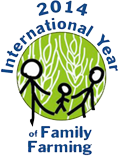Why Agriculture Needs Young People

Source: Food Tank
by Codrin Paveliuc Olariu
Currently, 2.5 billion people depend on agriculture for their livelihoods. Globally, the average age of farmers is around 55 years. According to the U.N. Food and Agriculture Organization (FAO) Statistical Yearbook 2013, 27 percent of the world's population is under 10 years old compared to only 8 percent over 65 years old. It's clear that agriculture needs to attract younger farmers.
In Europe, one-third of all farmers are under 35 and this portion of the population involved in agriculture is decreasing. The United States is also seeing an increase in the average age of farmers, with around 50 percent 55 years or older. In Africa, the region with the youngest population, almost 70 percent of people are under 35. Although 89 percent of all rural youth are employed in agriculture, access to education means this number is dropping, as young people search for urban opportunities.
What does this mean for the future of the family farm as fewer young people see agriculture as a career option?
For many regions of the world, GDP and agriculture are closely aligned. In Sub-Saharan Africa, 89 percent of rural youth who work in agriculture contribute, through their work outputs, one quarter to one third of Africa`s GDP. In a region where 40 percent of the population already lives in urban areas and urbanization continues to rapidly increase, this could mean big problems for the African economy. If Africa experiences just a 10 percent decrease of youth involved in family farming, or a decrease from the current 124.6 million to 112 million, Africa would see a fall in GDP and agricultural outputs, forcing the continent to rely more on imports. Depending on where urbanization occurs and the size of the farms, Africa`s GDP could decrease by up to 5 percent. Because 65-70 percent of all employment in Africa is agriculture based, this drop in GDP could increase unemployment, creating a vicious cycle, further lowering the GDP by at least one percent.
As a career option, agriculture tends not to be seen as a viable and economically sustainable career path. However, agriculture does not necessarily mean subsistence farming, even for family farms. Increased access to education means that young people can be a force for innovation on family farms, increasing incomes and well-being for not only farmers, but also local communities. Young people can develop the agricultural sector by applying new technologies to current work methods. A prime example of the changes that young people bring to agriculture is through communication and information technologies. Young farmers can easily connect with one another and share information ranging from weather to market prices.
The big question—for farmers, for businesses, and for policy-makers—is how we can promote agriculture as a feasible career option for young people worldwide?
Photo credit: ©FAO/Simon Maina



